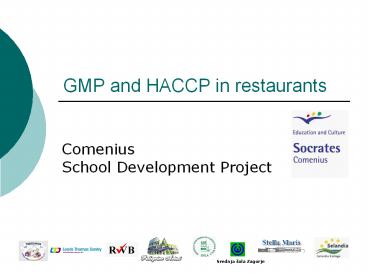GMP and HACCP in restaurants - PowerPoint PPT Presentation
1 / 15
Title:
GMP and HACCP in restaurants
Description:
GMP and HACCP in restaurants Comenius School Development Project Srednja ola Zagorje What are GMP s? Good Manufacturing Practices Good ... – PowerPoint PPT presentation
Number of Views:1745
Avg rating:3.0/5.0
Title: GMP and HACCP in restaurants
1
GMP and HACCP in restaurants
- ComeniusSchool Development Project
Stella Maris
Srednja šola Zagorje
2
What are GMPs?
- Good Manufacturing
Practices - Good manufacturing practices (GMPs) lie at the
heart of quality. - GMPs comprise a variety of practices that ensure
quality
3
What is HACCP?
- Have A Cup of Coffee Pray???
- (Dr. Jeannie Sneed, Iowa State)
- NO it means
- Hazard
- Analysis
- Critical
- Control
- Points
4
HACCP
- Its a big name, that seems to be scaring a lot
of people, but what it means to us in Food
Service is - A food safety program that must be based on HACCP
guidelines. - A properly designed and monitored system that
ensures the products we serve and the
preparation, storage and holding of those
products is done in the safest possible way.
5
History
- HACCP was first introduced in the 1960s at the
start of the space program. NASA used it first
and then it was introduced into the other
commercial areas Pillsbury and food
manufacturers.
6
Why?
- Entrepreneurs must use an HACCP system or a food
safety system - It provides a defense for us, against complaints
and legal action. - It focuses on food and places the responsibility
on Food Service Employees to serve safe food to
the guests. - It raises our professionalism to the next level.
- HACCP is a good thing, its a preventative
program!!
7
HACCP 7 Key Principals
- Identify hazards
- Identify critical control points
- Establish critical limits (time) for each control
point. - Establish Procedures to monitor the critical
control points. - Establish corrective actions to be taken when
monitoring shows that a critical limit has not
been met. - Establish procedures to verify that the system is
working. - Establish record keeping procedures to properly
maintain documents of the HACCP system.
8
The building blocks of a HACCP program
9
Food-Borne Illness
- Official definition of a food-borne disease
outbreak is when two or more cases of a similar
illness result from eating a common food - Each year in Europe 6.5 to 33 million of cases
-Cost estimation tens of billions of Euros. - Most food-borne illness results from
micro-organisms. - Customers can do their part in reducing the risk
by focusing on four critical steps - Clean wash hands and food contact surfaces
- Separate Dont cross contaminate
- Cook to proper temperatures
- Chill refrigerate promptly
10
Hygiene Code for Hotel and Catering
- The code is a simplified system specific to the
branch of industry for which the HACCP was
designed. - All current processes applied to the Hotel and
catering industry are included in the Hygiene
code. - If caterers act in accordance with the procedures
described in the hygiene code, they are acting in
accordance with the law. - The complete code can be downloaded from this
website.
11
Product liability
- Advise is to work according the Hygiene Code in
relation to product liability. - If a customer became ill after visiting your
establishment and holds you liable, you have to
respond. - With the application of the Hygiene Code you can
show that you have done what the law required
from you. - You can only do that if you have written down all
hygiene data and kept them.
12
Advantages
- In the short term
- A better product.
- Better process control.
- Better monitoring of raw materials.
- Clearer insight into your organization.
- Evidence in connection with product liability.
- In the long term
- Tasks, functions and responsibilities become
clearer. - Everyone is made to feel personally responsible.
- Trust in your firm will increase
- Evidence in connection with product liability.
13
This course
- Will enable you to highlight any health risks
that the preparation of products might present
for your customers. - These could arise from the moment you receive raw
materials up to and including when you clean up. - Will also give you some information about
- History of food safety and HACCP
- building, construction and equipment
- Micro- and macro-organisms
14
Chapters of this course
- Chapter 1 Introduction European guidelines
and Hygiene Code - Chapter 2 History of HACCP
- Chapter 3 Micro- and macro-organisms
- Chapter 4 Building and construction the
kitchen - Chapter 5 Building and construction other
departments - Chapter 6 Small kitchen materials
- Chapter 7 Kitchen equipment
- Chapter 8 Personal hygiene
- Chapter 9 Purchasing
- Chapter 10 Storage
- Chapter 11 Waste disposal
- Chapter 12 Quality and food safety
- Chapter 13 Preparation
- Chapter 14 Presenting and serving
- Chapter 15 Party catering
- Chapter 16 Product development
15
The end Chapter 1 - Introduction
Made by the Comenius team Stella Maris
Merksem Belgium































